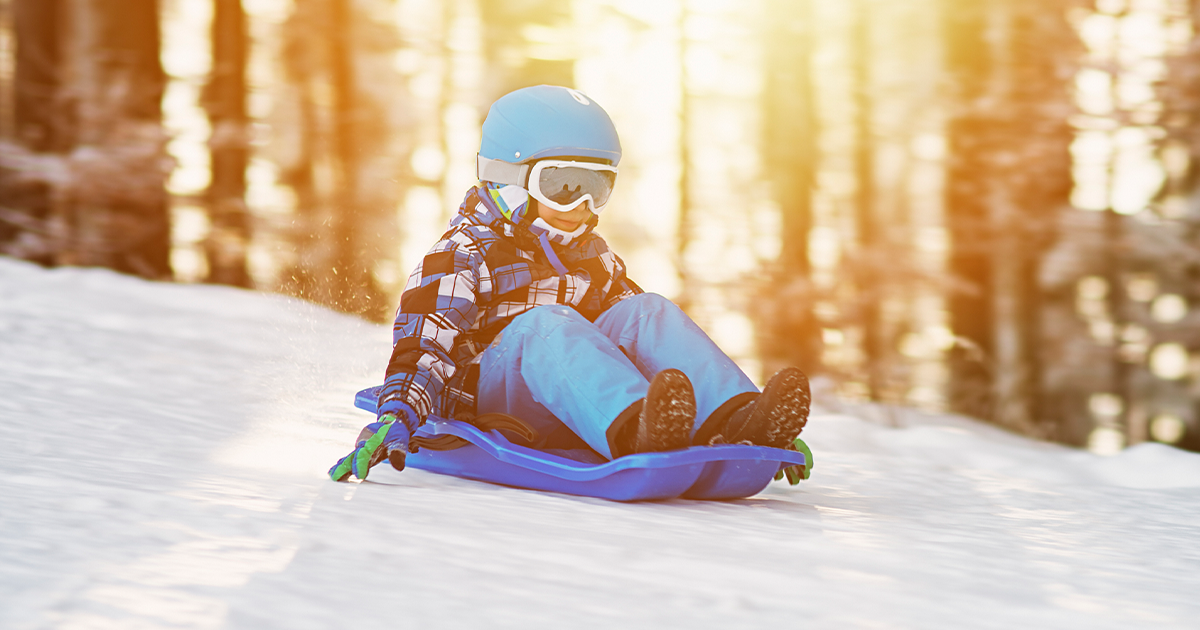We all know that safety belts save lives. In a car crash, the belt will prevent our bodies from impacting hard surfaces at high speeds. But how can protect our bodies when seat belts aren’t an option?
Did you know? A child on a sled can go as fast as a vehicle on a city street. A study from 2009 clocked sledders on various sliding surfaces at anywhere between 14 and 25 miles per hour!
Sledding is a great—and fun—way to stay active during a snowy Minnesota winter. But at Children’s Minnesota, we want to see kids safe. We’re sharing tips to protect yourself while having sledding.
Wear a helmet
Hitting your head on a hard surface can create injuries that last a lifetime. But a helmet can reduce the severity of that crash significantly. The good news: if you have a bike helmet, you have a sledding helmet!
Here’s how to tell if a helmet will help protect your head for sledding:
- Bicycle helmet: Look for a helmet with CPSC, ASTM F1447, Snell B-90/95 or Snell N-94 crash testing standards.
- Skateboard helmet: Look for a helmet with ASTM F1492 or Snell N-94 crash testing standards.
- Ski helmet: Look for a helmet with ASTM F-2040, CEN 1077, Snell RS-98 or S-98 crash testing standards.
Before using a helmet, check the label or packaging to ensure it follows one of the above crash testing standards. You can also find this information on the manufacturer’s website.

Make sure helmets fit properly
Follow these steps to adjust your child’s helmet:
- Sits level on their head.
- Is no more than two finger widths above their eyebrows.
- Is buckled so you can’t fit more than 1 finger between the strap and their chin.
- Forms a “V” under their ears.
- Does not wiggle when they turn their head from side to side.
To keep warm, kids can wear a thin hat or head wrap under a helmet. However, if the hat is too thick, it could lift the helmet too high off the head or might not allow the helmet to fit snuggly. If this happens, try to find a thinner hat and be aware of the possibility of cold-related injuries like frost bite.
Choose a safe hill
Some hills have hidden dangers that riders might not think about. Here are some tips to help you choose a safe place to sled:
- Sled on hills free of obstacles such as trees, rocks, signs, fences, tables and other immovable objects.
- Hills should be far enough away from streets, parking lots and water so sledders stay clear of these hazards.
- Take turns if there are many sledders on the same hill.
- Clear away from the bottom of the hill immediately.
- Walk up the sides of the hill.
- Take regular breaks to warm up and drink plenty of fluids.
- Wear warm, water-proof gloves, boots and clothes that are free from dangling items like strings and scarves.
Use the right equipment
- Use sleds that are appropriate size and shape for t your child.
- Sleds with brakes or steering capabilities can help sledders avoid crashes.
- Make sure to follow manufacturer’s instructions for the number of riders at a time.
- Go down on the hill feet-first on an appropriate sled.
Level 1 Trauma Center in Minneapolis
We are the area’s only Level I pediatric trauma center dedicated only to kids. Being designated as a Level I pediatric trauma center means that Children’s Minnesota Minneapolis hospital is recognized by the American College of Surgeons and the Minnesota Department of Health as offering the highest level of care for critically injured children.